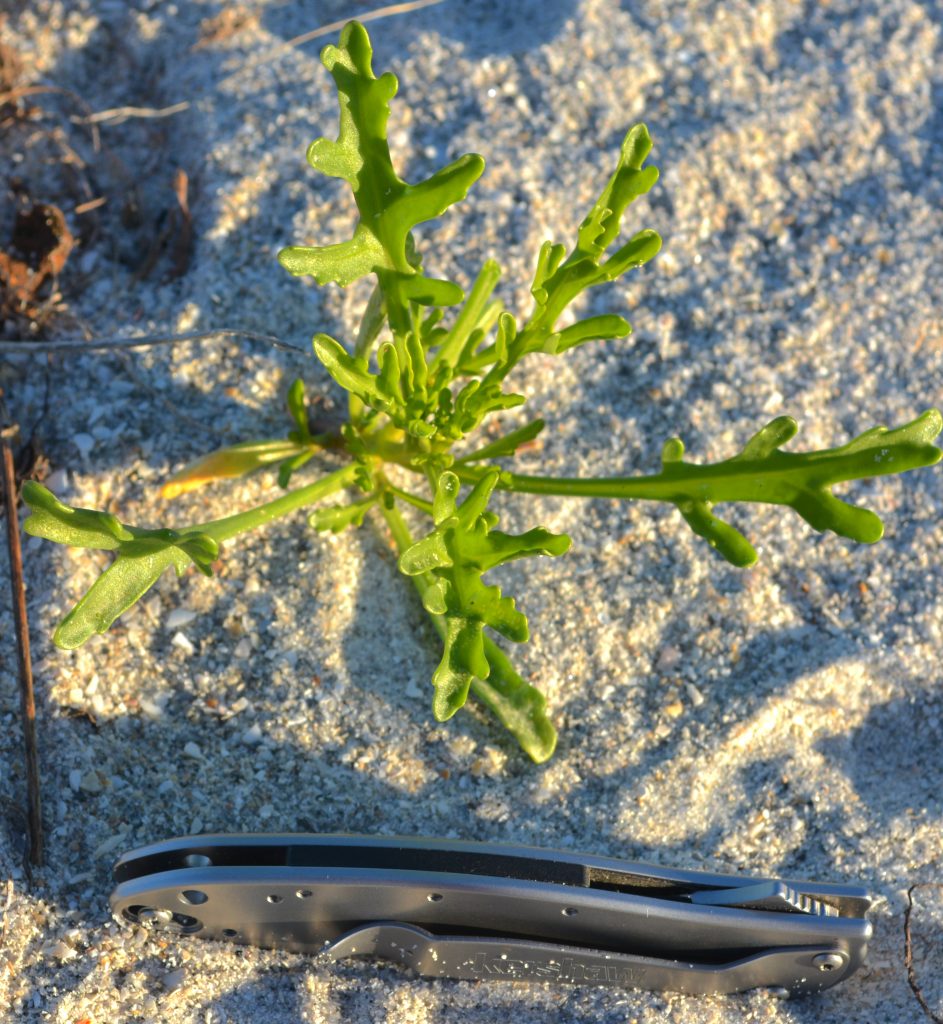
Sea Rocket is ending its seasonal run. Photo by Green Deane
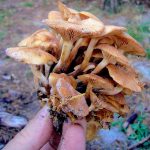
Ringless Honey Mushrooms grow from one crowded spot. Photo by Green Deane
The seasonal changing weather of April prompts changes in some forageables. Rain showers and cold nights can create a spring-time flush of ringless honey mushrooms. (left) There have been some reports of said on my Florida Mushroom Identification Forum on Facebook. And Sunday on the beach at Lori Wilson Park in Cocoa Beach we saw Sea Rocket (above) in transition, going to seed as we leave behind the cooler months all mustards prefer.
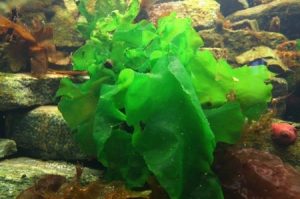
Sea Lettuce is perhaps the best of our local seaweeds.
On-shore winds from cold fronts on the west coast also allowed us to harvest sea lettuce in Port Charlotte Saturday. Sea Lettuce has something in common with wild mushrooms, it can’t be harvested in the wild and sold to restaurants. Long ago the way Florida decided to assure quality food supplies was to put a packing agency between sources of food and the sale there of. Thus it became the job of packing agencies to assure the food was what it said it was and was also of the quality to eat. So years ago when a restaurant in Port Canaveral had a sea lettuce salad made with Ulva lactuca, it was commercially grown lactuca not a wild harvest. For those curious the sea lattuce salad was a light delicate repast with sesame seed oil, chopped walnuts, water chestnuts and a few oyther Asian vegetables. Sea Lettuce is only two cells thick and mild in flavor. So additions provide the flavors.
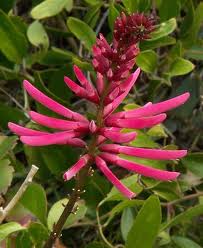
Eastern Coral Beans are easy to find this time of year. Photo by Green Deane
It is time to mention again Eastern Coral Bean, sometimes called the Cherokee Bean. What is odd about this plant is the edible flowers produce toxic beans. So we do not eat the red and black beans. A few of the red blossoms are edible raw — with precautions — but they are usually boiled then mixed with other foods notably scrambled eggs. When you cook the blossoms they turn light green. The distinctive uterine shape of the leaves makes the shrub easy to identify. Young leaves are edible cooked (boiled) but are marginal fare. Like Pawpaws they prefer dry, sunny places. A few raw red blossoms seem okay but if eaten in larger amounts they can be mind altering and approaching dangerous. Boiled they are fine. (Juice from the shrub’s stems, by the way, has been used to treat scorpion stings and the toxic beans have a chemical that is close to the alkaoid curare which can cause breathing paralysis.) You can see my video about the species here or read more about the Eastern Coral Bean here.
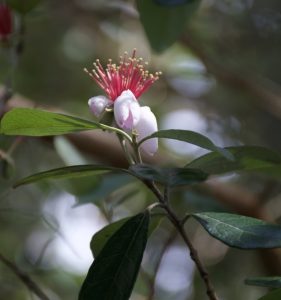
Pineapple Guava blossoms are always showy. Photo by Green Deane
Perhaps no ornamental has been championed as much as the Pineapple Guava, aka Feijoa, Acca sellowiana, Feijoa sellowiana. However the perfect shrub for many places never really caught on. There could be several reasons. It probably didn’t help that the Strawberry Guava is a severe invasive species in some locations. The Pineapple guava also does not get showy. You have to hunt for the extroverted blossoms. While the entire blossom is edible most people only eat the petals. Leaves can be made into a tea. Five or six months from now the fruit will be dark green and stay green as they ripen. The fruit just get softer. The shrub is easy to identify when in blossom, and it is blossoming now. Look for it in parks. To read more about both guavas, go here.

Foraging classes are held rain, shine, hot or cold. Photo by Nermina Krenata
April 22nd, Saturday, George LeStrange Preserve, 4911 Ralls Road, Fort Pierce, FL, 34981, 9 a.m. to noon.
April 23rd, Sunday, Mead Garden: 1500 S. Denning Dr., Winter Park, FL 32789. 9 a.m. to noon
Sunday April 29th, Eagle Lake Park, 1800 Keene Road, Largo, FL 33771. Meet at the pavilion near the dog park. 9 a.m.
Bring cash on the day of class or click here to pay for your class
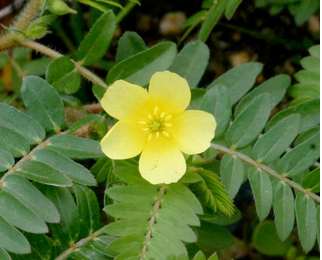
Tribulus terrestris is marginally edible. Photo by Green Deane
No leave it alone. Puncture vine, is a common low-growing sight now in park lawns. Cheery-looking, it is a questionable weight-lifting supplement in that it can shrink testes. The usual explanation is Tribulus terrestris — which is marginally edible — provides testosterone thus the gonads do not need to make it naturally so they give up the ghost so to say and shrink… permanently. A relative Kallstroemia maxima has the basic birth control pill hormone diosgenin. As Kallstroemia and Tribulus are closely related I would not make it a habit to eat or use either a lot whether male or female. I also question the fogginess of several references regarding plant hormones T. terrestris, which can stimulate testosterone production, is different than K. maxima which has diosgenin. That hormone was originally isolated in yams and used to make birth control pills. More to the point calling K. maxima a green viagra” as some writers do, would seem to be heading in the wrong direction with the wrong sex. The entire plant has been reported as a contraceptive for women. That’s quite chemical difference than being an analogue molecule for or stimulant for testosterone. Diosgenin can through several bodily processes end up as testosterone but it can also end up as estrogen. Puncture Vine might be all right as a food now and then but uses beyond that — such as dried and as a supplement or tea — should come under close chemical scrutiny.

You get the USB, not the key.
My nine-DVD set of 135 videos has been phased out and replaced by 171-videos on a 128-GB USB, see right. The USB videos are the same videos I have on You Tube. Some people like to have their own copy especially if social order falters. The USB videos have to be copied to your computer to play. If you want to order the USB go to the DVD/USB order button on the top right of this page or click here. That will take you to an order form. Or you can make a $99 donation, which tells me it is for the USB (include a snail-mail address.) I’d like to thank all of you who ordered the DVD set over the years which required me to burn over 5,000 DVDs individually. I had to stop making them as few programs now will read the ISO files to copy them. Burning a set also took about three hours.

Green Deane Forum
Want to identify a plant? Perhaps you’re looking for a foraging reference? You might have a UFO, an Unidentified Flowering Object, you want identified. On the Green Deane Forum we — including Green Deane and others from around the world — chat about foraging all year. And it’s not just about warm-weather plants or just North American flora. Many nations share common weeds so there’s a lot to talk about. There’s also more than weeds. The reference section has information for foraging around the world. There are also articles on food preservation, and forgotten skills from making bows to fermenting food. Recent topics include: Stale Bread and Cod Liver Oil, Killing Bugs with Tobacco Plugs, Eating weeds: Is it safe? Have they mutated? Not the Eastern Red Bug but the Pink Tabebuia, African Tulip Tree, Asparagus densiflorus, Green Deane’s Book… You can join the forum by clicking on the button on the upper right hand side of this page.
This is my weekly newsletter #554. If you want to subscribe to this free newsletter you can find the sign-up form in the menu at the top of the page. My website, EatTheWeeds.com, which is data secure, has over 1500 plants on it in some 428 articles. I wrote every one myself, no cut and paste.
To donate to the Green Deane Newsletter click here.

